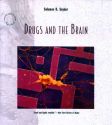Did you know that heroin was once legally sold as a cough syrup, that lithium (the same thing I put in my watch?) is the magical drug for bi-polar disorders though no one can explain how it works? That cocaine, after being advocated by Freud, was as popular then in the pharmacies as Valium is today? That the first anti-depressants were initially designed against tuberculosis, or that morphine-based compound are used in most anti-diarrhea pills ? I surely didn’t, and apart from being a solid and scientifically grounded book, Solomon Snyder succeeded in making Drugs and the Brain a very digestible and reader-friendly book by adding a very helpful visual and historical background to his explanations.
I finally discovered in a friendly manner what stands behind all those mysterious words that we cross with an increasing frequency: neurotransmitters, 5HT, serotonin, dopamine, agonist, antagonist, synapses. I am no scientist nor very educated in biology; still most of the technical part was not out of my reach. Things are presented more as in a textbook than as in a scientific journal, and illustrations support each new concept in most cases. I learned about the different systems present in the brain and their related functions: serotonin works on the mood, adrenaline on the nerves, acetylcholine on the muscles (to criminally over-schematize) and each such system is studied through its relation with one or different drugs and through the consequences of its malfunctioning.
Malfunctions or pathologies are indeed the starting point when researching new drugs. After an initial section on brain biology and pharmacology where the reader is familiarized with basic neurotransmission processes, the journey starts at the end of the 19th century with the opiates, immensely useful for their analgesic and emotional relaxing properties and dangerous at the same time for their abuse potential, the first drugs to be developed historically and associated with the most important problems of drug abuse today. How curious it is to learn that the brain itself generates a morphine-like substance, whose recent synthesis opens promising research perspectives for the elaboration of a non-addictive potent analgesic!
Neuroleptics form the basis of chapter three, being one of the most helpful classes of psychiatric drugs of the last 50 years. Chlorpromazine and reserpine, both popularized in the 1950s, brought an end to the forced—and many times tragic—medicalization of schizophrenics. At the same time, it led scientists to question the dopaminergic system and put forward evidence of dopamine depletion in Parkinson’s disease. Chapter four opens the gates of a very modern universe: depression, mania and mood enhancers. Research in this field was fueled by the challenges scientists faced when trying to develop valid antischizophrenics. The first class of antidepressants were the monoamine oxidase inhibitors (MAOI), whose efficiency was balanced by their dangerous association with many foods. Then the tricyclic antidepressants were developed, which brought the understanding of a new process of neurotransmission: the inhibition of the recapture of neurotransmitters by the discharging neuron. And finally came the most bizarre discovery in the field, the balancing and then-mysterious effect of the metal lithium for both depression and mania.
A beautiful picture of the city of Machu Picchu paves the way to the stimulants of chapter five, a crumbling remnant of a culture where cocaine was routinely used. Cocaine was used in the late 19th century, and is still largely used today in modified form as a local anesthetic. Amphetamine appeared around 1935, as an easily producible analogue to ephedrine. Tapping into the dopaminergic and noradrenergic systems, stimulants directly affect the attention and affective systems and are responsible for schizophrenic-like psychosis. After the stimulants the author takes us to the anxiolitics, an increasing problem in our overstretched societies. Research in this field led to the development of a new class of psychotropic drugs, the benzodiazepines, with their king Valium, appeared in 1963. Although much less toxic than the barbiturates, this class still creates an undesirable dependence and is highly dangerous when combined with other depressives like alcohol.
Finally the last chapter leads the author to the psychedelic drugs, or namely “enlightenment in a pill”. LSD, DOM, MDMA, DOET, TMA and DMT are among the inhabitants of this world. After an historical presentation, we are shown how those drugs can and do help scientists penetrate the mist of human consciousness as probes that they use to try to better understand brain chemistry and pharmacodynamics.
At a time when human life and death is dictated normatively by cerebral activity, when the boundaries of “normalcy” become increasingly blurred thanks to an increasing medicalization of our social life, and when brain “fingerprinting” is plunging us deep into personal identity and intimacy, it is increasingly important to understand what is going on in our brains. And this book is a good starting point, using the psychiatric field and its traditional pathologies to give an insight into how brain neurotransmission works and how physical brain systems and physical or psychological functions relate to each other. I would definitively recommend it to the neophyte reader, as a good overall overview of neurotransmission, or as an entry point for both psychopharmacology and neuropsychiatry fields.
Fatal error: Uncaught TypeError: count(): Argument #1 ($value) must be of type Countable|array, null given in /www/library/review/review.php:699 Stack trace: #0 {main} thrown in /www/library/review/review.php on line 699


